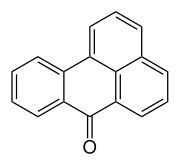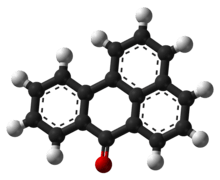Benzanthrone
Benzanthrone (BZA) is an aromatic hydrocarbon derivate used as a dyestuff intermediate for anthraquinone-based dyes. It has the appearance of a light yellow to brown-green powder with melting point of 170 °C. It is insoluble in water and soluble in alcohol.
 | |
 | |
| Names | |
|---|---|
| IUPAC name
7H-Benzo[de]anthracen-7-one | |
| Other names
Benzanthrenone 1,9-Benzanthrone MS-Benzanthrone Mesobenzanthrone Naphtanthrone 7H-Benz(de)anthracene-7-one 7-Oxobenz(de)anthracene | |
| Identifiers | |
3D model (JSmol) |
|
| ChEBI | |
| ChEMBL | |
| ChemSpider | |
| ECHA InfoCard | 100.001.268 |
| EC Number |
|
PubChem CID |
|
| UNII | |
| UN number | 2811 |
CompTox Dashboard (EPA) |
|
| |
| |
| Properties | |
| C17H10O | |
| Molar mass | 230.266 g·mol−1 |
| Appearance | Light yellow to brown-green solid |
| Melting point | 170 °C (338 °F; 443 K) |
| Insoluble | |
| Hazards | |
| GHS pictograms |  |
| GHS Signal word | Warning |
GHS hazard statements |
H315, H319, H335 |
| P261, P264, P271, P280, P302+352, P304+340, P305+351+338, P312, P321, P332+313, P337+313, P362, P403+233, P405, P501 | |
Except where otherwise noted, data are given for materials in their standard state (at 25 °C [77 °F], 100 kPa). | |
| Infobox references | |
It is a basic substance with fluorescent and luminescent properties. It can be used for photosensitization, and as a charge transport material. It is also used in pyrotechnics industry, mainly as a component of some older formulations of green and yellow colored smokes, often together with Vat Yellow 4; its US military specification is MIL-D-50074D.[1]
Safety Measures
Benzanthrone causes itching and burning sensations on exposed skin, together with erythema, dermatitis, and skin pigmentation.[2]
See also
References
- "Appendix A: Benzanthrone". Toxicity of Military Smokes and Obscurants. Volume 3. 1999.
This article is issued from Wikipedia. The text is licensed under Creative Commons - Attribution - Sharealike. Additional terms may apply for the media files.